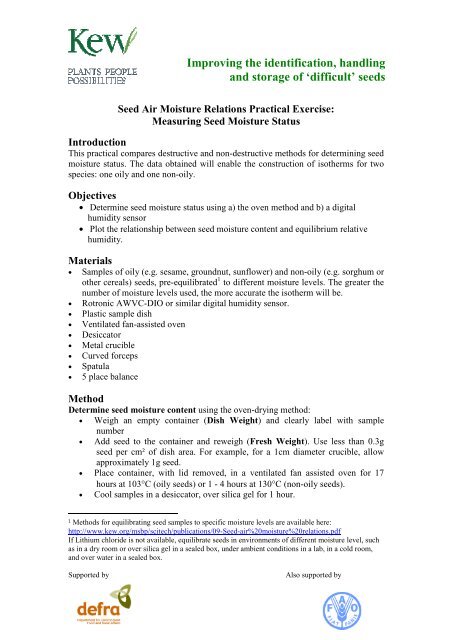Practical - Measuring seed moisture status
Practical - Measuring seed moisture status
Practical - Measuring seed moisture status
You also want an ePaper? Increase the reach of your titles
YUMPU automatically turns print PDFs into web optimized ePapers that Google loves.
Improving the identification, handling<br />
and storage of ‘difficult’ <strong>seed</strong>s<br />
Seed Air Moisture Relations <strong>Practical</strong> Exercise:<br />
<strong>Measuring</strong> Seed Moisture Status<br />
Introduction<br />
This practical compares destructive and non-destructive methods for determining <strong>seed</strong><br />
<strong>moisture</strong> <strong>status</strong>. The data obtained will enable the construction of isotherms for two<br />
species: one oily and one non-oily.<br />
Objectives<br />
• Determine <strong>seed</strong> <strong>moisture</strong> <strong>status</strong> using a) the oven method and b) a digital<br />
humidity sensor<br />
• Plot the relationship between <strong>seed</strong> <strong>moisture</strong> content and equilibrium relative<br />
humidity.<br />
Materials<br />
• Samples of oily (e.g. sesame, groundnut, sunflower) and non-oily (e.g. sorghum or<br />
other cereals) <strong>seed</strong>s, pre-equilibrated 1 to different <strong>moisture</strong> levels. The greater the<br />
number of <strong>moisture</strong> levels used, the more accurate the isotherm will be.<br />
• Rotronic AWVC-DIO or similar digital humidity sensor.<br />
• Plastic sample dish<br />
• Ventilated fan-assisted oven<br />
• Desiccator<br />
• Metal crucible<br />
• Curved forceps<br />
• Spatula<br />
• 5 place balance<br />
Method<br />
Determine <strong>seed</strong> <strong>moisture</strong> content using the oven-drying method:<br />
• Weigh an empty container (Dish Weight) and clearly label with sample<br />
number<br />
• Add <strong>seed</strong> to the container and reweigh (Fresh Weight). Use less than 0.3g<br />
<strong>seed</strong> per cm² of dish area. For example, for a 1cm diameter crucible, allow<br />
approximately 1g <strong>seed</strong>.<br />
• Place container, with lid removed, in a ventilated fan assisted oven for 17<br />
hours at 103°C (oily <strong>seed</strong>s) or 1 - 4 hours at 130°C (non-oily <strong>seed</strong>s).<br />
• Cool samples in a desiccator, over silica gel for 1 hour.<br />
1 Methods for equilibrating <strong>seed</strong> samples to specific <strong>moisture</strong> levels are available here:<br />
http://www.kew.org/msbp/scitech/publications/09-Seed-air%20<strong>moisture</strong>%20relations.pdf<br />
If Lithium chloride is not available, equilibrate <strong>seed</strong>s in environments of different <strong>moisture</strong> level, such<br />
as in a dry room or over silica gel in a sealed box, under ambient conditions in a lab, in a cold room,<br />
and over water in a sealed box.<br />
Supported by<br />
Also supported by
Improving the identification, handling<br />
and storage of ‘difficult’ <strong>seed</strong>s<br />
• Weigh container with <strong>seed</strong> (Dry Weight).<br />
• Calculate <strong>moisture</strong> loss and express as % (fresh weight basis):<br />
Moisture content (% fresh weight) = fresh weight – dry weight x 100<br />
fresh weight – dish weight<br />
Determine <strong>seed</strong> eRH using Rotronic AWVC-DIO.<br />
• Remove the lid from a plastic sample dish containing <strong>seed</strong>s and place this in<br />
the chamber. The <strong>seed</strong>s should take up a minimum of 20% of the chamber in<br />
order to dominate the system within the chamber.<br />
• Clamp the Rotronic probe to the chamber and leave the lid, clearly labelled,<br />
next to the instrument.<br />
• Once the sample has equilibrated (approximately 15-20 min) return to take a<br />
reading of eRH.<br />
Results<br />
Species Sample Rep Dish<br />
Weight<br />
Oily: 1 I<br />
II<br />
2 I<br />
II<br />
3 I<br />
II<br />
4 I<br />
II<br />
Nonoily:<br />
1 I<br />
II<br />
2 I<br />
II<br />
3 I<br />
II<br />
4 I<br />
II<br />
Fresh<br />
Weight<br />
Dry<br />
Weight<br />
Moisture<br />
Content<br />
Supported by<br />
Also supported by
Improving the identification, handling<br />
and storage of ‘difficult’ <strong>seed</strong>s<br />
Species<br />
Oily:<br />
Non-oily:<br />
eRH reading<br />
Sample<br />
eRH Temp ºC<br />
1 %<br />
2 %<br />
3 %<br />
4 %<br />
1 %<br />
2 %<br />
3 %<br />
4 %<br />
Moisture Content<br />
Plot mc against eRH<br />
25<br />
20<br />
MC%<br />
15<br />
10<br />
5<br />
0<br />
0 10 20 30 40 50 60 70 80 90 100<br />
eRH%<br />
Questions<br />
• What was the temperature at which you recorded eRH?<br />
• If the eRH measurements had been taken at a higher temperature, what effect<br />
would this have had on the isotherm?<br />
Supported by<br />
Also supported by
















